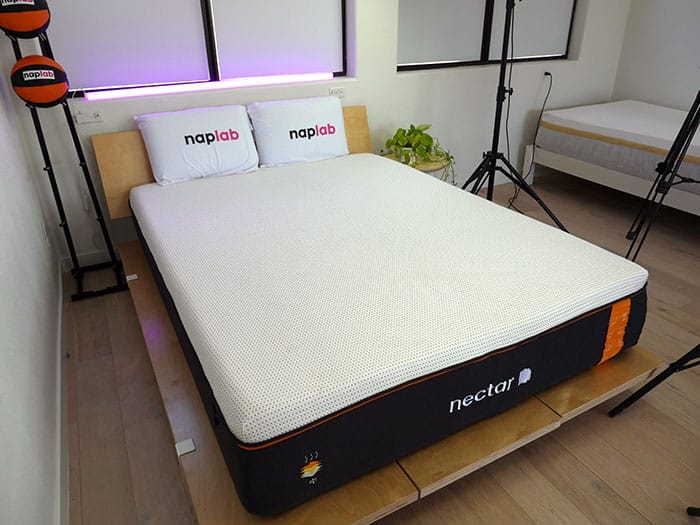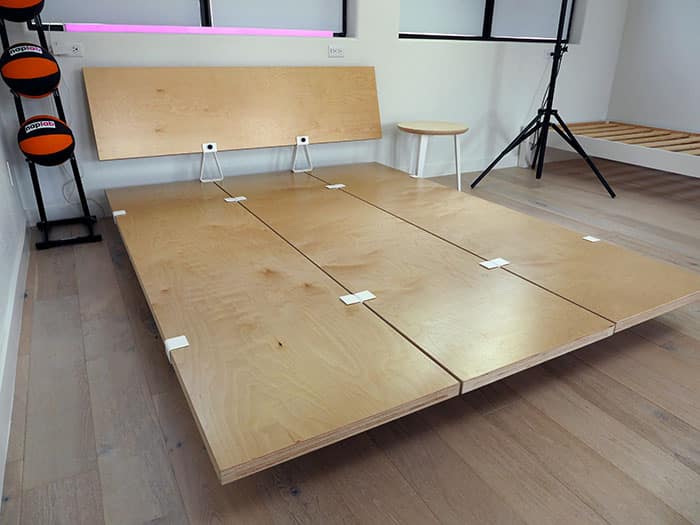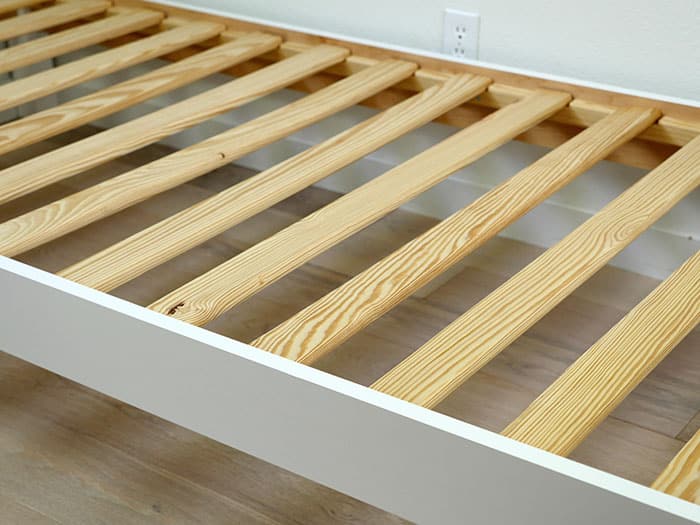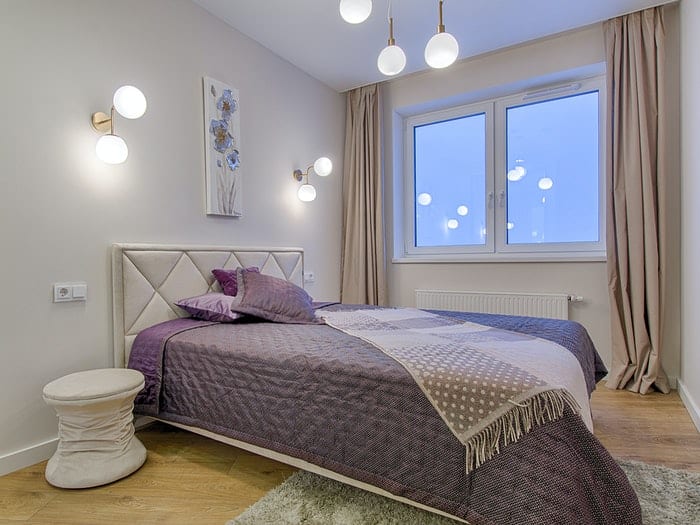Ready to buy a new bed? Whether you’re seeking increased comfort, style, or functionality, there are plenty of options to choose from. Platform beds, for instance, have a sleek design that can be tailored to your needs.
But what is a platform bed and how does it differ from other bed styles? Most importantly, is it right for you?

Platform Bed Defined
A platform bed features a solid platform or slats to support the mattress. Since it doesn’t require a box spring or foundation, it takes less space than other models.
With their compact design, platform beds are ideal for minimalists, ensuring the right balance between aesthetics and functionality. Below we’ll discuss their potential advantages and drawbacks to help you make an informed decision.
What Is a Platform Bed?
Nowadays, there are as many types of beds on the market as there are mattresses. Consumers can also opt for panel beds, canopy beds, sleigh beds, trundle beds, and everything in between.

A typical platform bed (sometimes referred to as a European bed) consists of a rectangular frame with plywood or built-in slats placed two to three inches apart. Depending on your needs, you can choose a model with visible legs or one with center support.

Generally, platform beds are suitable for most types of mattresses, including coil, latex, polyfoam, and memory foam models.
Compared to traditional beds, they’re closer to the ground and have a built-in foundation. This eliminates the need for additional support, such as a box spring or foundation.

Most notably, a platform bed takes the place of a box spring or other foundation. If you are using a well-built quality platform bed, then you do not need to use a box spring or foundation.
What Does a Platform Bed Look Like?
These pieces of furniture have either a large, solid base or slats designed to support the mattress. The slats promote air circulation, which may help improve cooling and reduce heat buildup in the mattress. Some models have at least one extra leg in the center of the frame for increased stability.

Platform beds are available in a variety of styles including with or without headboards and footboards. If you have limited space in your home or apartment, consider buying a bed with storage drawers.
What makes these products stand out is their versatility. Platform beds come in dozens of styles and designs, from loft-style beds to floating beds.

Some are made from metal, while others are made from wood or bamboo. They are also available in the most common mattress sizes.
Platform beds are typically between 12 and 24 inches off the ground, though there is no standard height. Certain models can be used with a foundation or box springs for added height. However, this largely defeats the primary purpose of the platform bed, which is to provide a lower profile bed frame.
Types of Platform Beds
In the past, platform beds looked basic compared to other bed styles. Today, many manufacturers offer unique designs for every taste and budget. Let’s see a few examples:
- Modern platform beds featuring minimalist designs, clean lines, and natural materials like wood or bamboo
- Contemporary beds with a low profile and minimalist styles
- Traditional platform beds with intricate details and embellishments
- Storage platform beds, which have a basic functional design
- Wooden beds covered with upholstery
- Eco-friendly platform beds made from reclaimed wood or other natural materials
- Hardwood mission beds, which tend to have a basic design and can last for decades
- Floating platform beds, which feature a hidden support structure underneath the mattress base

Modern platform beds, for instance, feature a mix of contemporary and traditional elements. They tend to have a low to medium profile and eye-catching designs. Traditional beds, by comparison, have a higher profile and more intricate details.

You may further customize your bed by adding a headboard, footboard, canopy, or drawers, depending on the model. These small touches can enhance its functionality and visual appeal.
Know Your Options
The above bed styles can be classified into several categories based on size, materials, and type of surface.

For example, some platform beds have a solid surface with holes that promote airflow. They also tend to provide better support than those with slats.
Other models feature metal rails and therefore, may not be suitable for latex, poly-, and memory foam mattresses as they may cause the foam to sag. However, they are sturdy and can accommodate most types of spring mattresses.

Whether the surface is metal, wood, composite, or other materials, the more solid the foundation, the better the support it is able to provide—and the wider variety of mattress types it can accommodate.
Wooden slats and metal bars can support foam-type mattresses, provided the gaps between those slats and bars are not too wide (typically no more than 2-3”).
How to Choose a Platform Bed
A platform bed is first and foremost about performance. If it cannot well support your mattress, then it’s not a good platform bed.
The best platform beds are those that have a single solid platform surface with no holes, slats, or gaps. The platform foundation should be rigid and without much flex.
These types of platform beds provide the best foundational support for your mattress, which in turn leads to the best performance from your mattress and is more likely to extend its life.

Platform beds that utilize slats, metal bars, holes, multiple foundational pieces, etc. can still be a good fit. However, these are more likely to cause support issues for your mattress.
If you do opt for a mattress that utilizes a non-single piece foundation, you want to look for materials that are more rigid and have gaps of no more than 3”.
There are other aspects you should take into account as well:
- Open-frame beds are suitable for minimalist bedrooms.
- If you toss and turn a lot during sleep, a headboard will keep your pillows in place.
- Headboards are also a good choice for those who watch TV or read in bed. Open-frame beds are not as comfortable from this perspective.
- Upholstered beds feature a timeless design but require more maintenance compared to metal or wooden bed frames. If you prefer this model, vacuum the upholstery regularly to remove dust.
- Metal bed frames are ideal for creating a modern or industrial look, while wood makes a great choice for rustic homes.
- Consider the size of your bedroom. Ideally, there should be at least two or three feet of space between your bed and the walls.
- Select a bed frame with sturdy slates so they can support your weight and the mattress you sleep on. Hardwood slats are typically stronger than pine and other softwoods.
What Are the Benefits of a Platform Bed?
Many consumers prefer platform beds over other styles due to their convenience. These models can be assembled in minutes and accommodate most types of mattresses. Plus, they don’t require a box spring, leading to cost savings.

As Modsy notes, platform beds can fit into small spaces and make it easier to reduce clutter. Those with built-in storage are perfect for studios, children’s bedrooms, and minimalist interiors.
Benefits of a Platform Bed
- Increased mattress support due to the sturdy base
- No need for a bed skirt
- Available in a large variety of styles
- Compatible with most types of mattresses
- Sleek, modern design
- The option to install a headboard, footboard, or box spring if necessary
Depending on the model, platform beds may have more space underneath than a box spring and other bed styles. Therefore, you’ll find it easier to vacuum and clean the floor, which can prevent dust mites from settling in your bedroom.
Are There Any Drawbacks?
As previously discussed, these bed frames feature a variety of styles and designs. Some are more comfortable and convenient than others.
- Limited underbed space: For example, floating platform beds have little or no space underneath, so you need to lift or move them when cleaning the floor. If you don’t do it often enough, you might end up with dust mites, bed bugs, and dust in your bedroom.
Our advice is to choose a model that has at least a few inches of under-bed space.
- Possibly noisy: Beware that certain models, especially those made from MDF or particleboard, tend to squeak because they’re hollow inside.
Additionally, the screws and other components may be loose, making awkward sounds with every movement.
- Difficult for people with limited mobility: Another drawback is related to their design. People with limited mobility may find it difficult to get in and out of a platform bed. Their firm surface may also put pressure on the joints and soft tissues.
Are Platform Beds Worth It?
Platform beds strike the balance between comfort, functionality, and aesthetics. Plus, they come in all sizes and can be a great choice for small spaces.

Their price starts at $200 and can go up to $3,000 or more, depending on the brand, materials, size, and design.
Try not to go for the cheapest model. Ideally, choose a model that includes the most rigid and solid foundation as this will provide the best support to the mattress.
We hope this article answered your question—What is a platform bed? Our recommendation is to shop around, assess your options, and read customer reviews.
Consider your sleep position and any mobility issues you may have, as well as your bedroom décor, to make the right choice.


